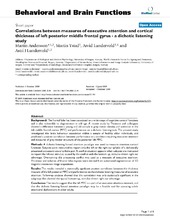Correlations between measures of executive attention and cortical thickness of left posterior middle frontal gyrus - a dichotic listening study
Peer reviewed, Journal article
Published version

Permanent lenke
http://hdl.handle.net/1956/7498Utgivelsesdato
2009-10-01Metadata
Vis full innførselSamlinger
Originalversjon
https://doi.org/10.1186/1744-9081-5-41Sammendrag
Background: The frontal lobe has been associated to a wide range of cognitive control functions and is also vulnerable to degeneration in old age. A recent study by Thomsen and colleagues showed a difference between a young and old sample in grey matter density and activation in the left middle frontal cortex (MFC) and performance on a dichotic listening task. The present study investigated this brain behaviour association within a sample of healthy older individuals, and predicted a positive correlation between performance in a condition requiring executive attention and measures of grey matter structure of the posterior left MFC. Methods: A dichotic listening forced attention paradigm was used to measure attention control functions. Subjects were instructed to report only the left or the right ear syllable of a dichotically presented consonant-vowel syllable pair. A conflict situation appears when subjects are instructed to report the left ear stimulus, caused by the conflict with the bottom-up, stimulus-driven right ear advantage. Overcoming this processing conflict was used as a measure of executive attention. Thickness and volumes of frontal lobe regions were derived from automated segmentation of 3D magnetic resonance image acquisitions. Results: The results revealed a statistically significant positive correlation between the thickness measure of the left posterior MFC and performance on the dichotic listening measures of executive attention. Follow-up analyses showed that this correlation was only statistically significant in the subgroup that showed the typical bottom-up, stimulus-driven right ear advantage. Conclusion: The results suggest that the left MFC is a part of an executive attention network, and that the dichotic listening forced attention paradigm may be a feasible tool for assessing subtle attentional dysfunctions in older adults.
